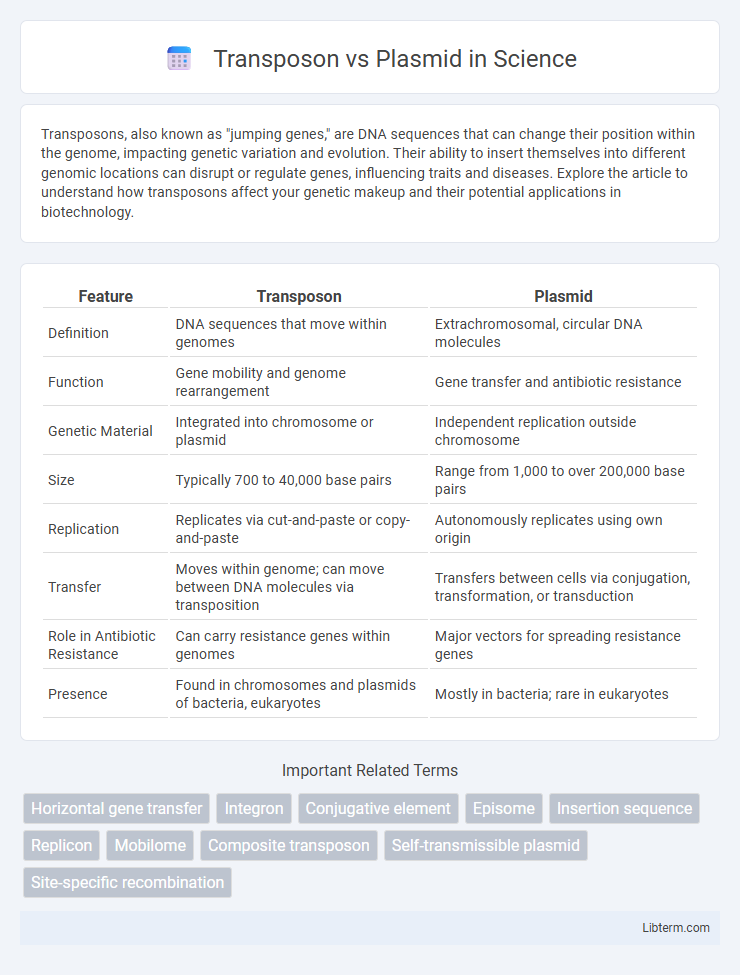Transposons, also known as "jumping genes," are DNA sequences that can change their position within the genome, impacting genetic variation and evolution. Their ability to insert themselves into different genomic locations can disrupt or regulate genes, influencing traits and diseases. Explore the article to understand how transposons affect your genetic makeup and their potential applications in biotechnology.
Table of Comparison
| Feature | Transposon | Plasmid |
|---|---|---|
| Definition | DNA sequences that move within genomes | Extrachromosomal, circular DNA molecules |
| Function | Gene mobility and genome rearrangement | Gene transfer and antibiotic resistance |
| Genetic Material | Integrated into chromosome or plasmid | Independent replication outside chromosome |
| Size | Typically 700 to 40,000 base pairs | Range from 1,000 to over 200,000 base pairs |
| Replication | Replicates via cut-and-paste or copy-and-paste | Autonomously replicates using own origin |
| Transfer | Moves within genome; can move between DNA molecules via transposition | Transfers between cells via conjugation, transformation, or transduction |
| Role in Antibiotic Resistance | Can carry resistance genes within genomes | Major vectors for spreading resistance genes |
| Presence | Found in chromosomes and plasmids of bacteria, eukaryotes | Mostly in bacteria; rare in eukaryotes |
Introduction to Transposons and Plasmids
Transposons, or "jumping genes," are DNA sequences that can change their position within the genome, causing mutations and altering the cell's genetic identity, playing a significant role in genetic diversity and evolution. Plasmids are small, circular, double-stranded DNA molecules separate from chromosomal DNA, commonly found in bacteria, and often carry genes beneficial for survival, such as antibiotic resistance. Both transposons and plasmids are key elements in horizontal gene transfer, facilitating genetic variation and adaptation in microbial populations.
Defining Transposons: Structure and Function
Transposons, also known as "jumping genes," are DNA sequences capable of moving within and between genomes, playing a crucial role in genetic variation and genome evolution. Structurally, they consist of a transposase gene flanked by inverted repeat sequences that enable their cutting and reinsertion into new genomic locations. Functionally, transposons facilitate horizontal gene transfer, promote genome plasticity, and can influence gene expression by inserting near or within genes.
Understanding Plasmids: Key Characteristics
Plasmids are autonomous, double-stranded DNA molecules that replicate independently of the chromosomal DNA in bacteria, often carrying genes beneficial for antibiotic resistance or metabolic functions. Unlike transposons, which are mobile genetic elements capable of moving within and between DNA molecules, plasmids exist as separate, circular DNA entities capable of horizontal transfer via conjugation. Their stable replication and ability to transfer genes across bacterial populations make plasmids a crucial factor in genetic variation and biotechnology applications.
Mechanisms of Genetic Mobility: Transposons vs Plasmids
Transposons mobilize within genomes via a "cut-and-paste" or "copy-and-paste" mechanism mediated by transposase enzymes, facilitating gene rearrangements and horizontal gene transfer. Plasmids replicate independently as circular DNA molecules and transfer between bacteria primarily through conjugation, often carrying antibiotic resistance genes. Both elements drive genetic diversity but differ in mobility, with transposons integrating into chromosomes and plasmids existing extrachromosomally.
Roles in Horizontal Gene Transfer
Transposons and plasmids both facilitate horizontal gene transfer but operate through distinct mechanisms. Plasmids replicate independently and transfer genes via conjugation, often spreading antibiotic resistance among bacteria. Transposons move within and between DNA molecules, including plasmids and chromosomes, enabling gene rearrangement and the mobilization of gene clusters across diverse genetic contexts.
Impact on Antibiotic Resistance
Transposons contribute significantly to the spread of antibiotic resistance by facilitating the movement of resistance genes between different DNA molecules within a bacterial cell, enabling rapid genetic adaptation. Plasmids serve as key vectors in horizontal gene transfer, often carrying multiple antibiotic resistance genes and spreading them across diverse bacterial populations. The combined action of transposons and plasmids accelerates the dissemination and persistence of multidrug resistance in pathogenic bacteria, complicating treatment strategies and public health efforts.
Applications in Genetic Engineering
Transposons serve as powerful tools for mutagenesis and gene tagging in genetic engineering, enabling the insertion of specific DNA sequences into host genomes to study gene function and regulation. Plasmids are widely utilized as vectors to clone, propagate, and express recombinant genes in bacterial or eukaryotic cells, facilitating protein production and gene therapy research. The versatility of plasmids in carrying selectable markers and regulatory elements complements the ability of transposons to disrupt or mobilize genomic sequences, making both essential for genome manipulation and functional genomics.
Detection and Analysis Methods
Transposon detection primarily utilizes PCR-based techniques, next-generation sequencing (NGS), and Southern blotting to identify insertion sites and copy numbers within genomes. Plasmid analysis involves plasmid isolation followed by gel electrophoresis, restriction fragment length polymorphism (RFLP), and sequencing methods to determine plasmid size, structure, and gene content. Bioinformatics tools aid in comparative analysis and annotation for both transposons and plasmids, enhancing understanding of their roles in gene transfer and antibiotic resistance.
Evolutionary Significance and Diversity
Transposons drive genetic diversity by facilitating gene rearrangements and horizontal gene transfer, significantly impacting genome evolution across diverse species. Plasmids contribute to evolutionary adaptability by enabling rapid acquisition and dissemination of advantageous traits, such as antibiotic resistance, in bacterial populations. Both elements serve as crucial mechanisms for genetic variation and adaptation, promoting evolutionary innovation and microbial resilience.
Summary: Key Differences and Similarities
Transposons are mobile genetic elements that can move within and between genomes, often carrying antibiotic resistance genes, while plasmids are independent, circular DNA molecules primarily found in bacteria that replicate autonomously and can transfer genetic information horizontally. Both transposons and plasmids contribute to genetic diversity and adaptability, facilitating gene transfer among prokaryotes. Unlike plasmids, transposons lack independent replication but integrate into host genomes, making their mobility and replication mechanisms distinct.
Transposon Infographic

 libterm.com
libterm.com